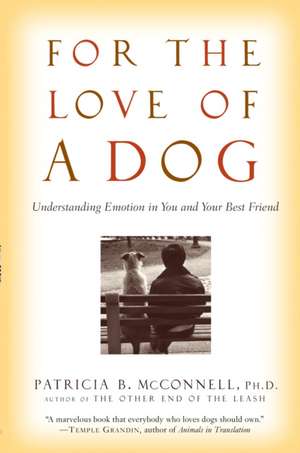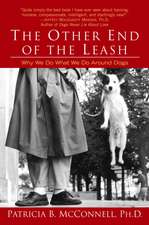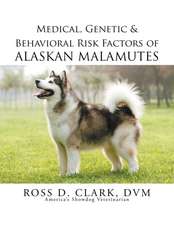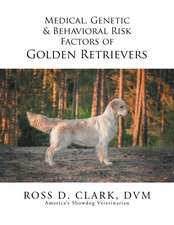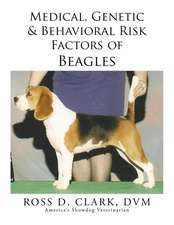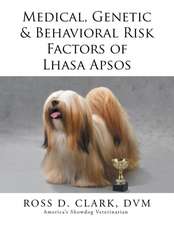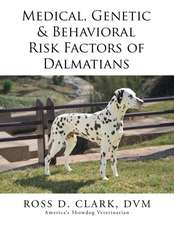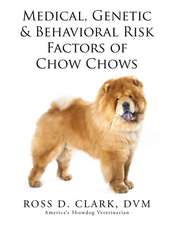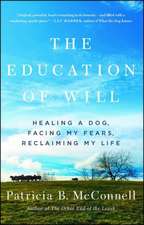For the Love of a Dog: Understanding Emotion in You and Your Best Friend
Autor Patricia B. McConnellen Limba Engleză Paperback – 31 iul 2007
Vezi toate premiile Carte premiată
In For the Love of a Dog, McConnell suggests that one of the reasons we love dogs so much is that they express emotions in ways similar to humans. After all, who can communicate joy better than a puppy? But not all emotional expressions are obvious, and McConnell teaches both beginning dog owners and experienced dog lovers how to read the more subtle expressions hidden behind fuzzy faces and floppy ears.
For those of us who deeply cherish our dogs but are sometimes baffled by their behavior, For the Love of a Dog will come as a revelation–a treasure trove of useful facts, informed speculation, and intriguing accounts of man’s best friend at his worst and at his very best. Readers will discover how fear, anger, and happiness underlie the lives of both people and dogs and, most important, how understanding emotion in both species can improve the relationship between them. Thus McConnell introduces us to the possibility of a richer, more rewarding relationship with our dogs.
While we may never be absolutely certain what our dogs are feeling, with the help of this riveting book we can understand more than we ever thought possible. Those who consider their dogs part of the family will find For the Love of a Dog engaging, enlightening, and utterly engrossing.
From the Hardcover edition.
Preț: 98.15 lei
Nou
18.79€ • 20.41$ • 15.79£
Carte disponibilă
Livrare economică 31 martie-14 aprilie
Specificații
ISBN-10: 0345477154
Pagini: 332
Ilustrații: 16 PAGE BLACK AND WHITE INSERT
Dimensiuni: 134 x 202 x 21 mm
Greutate: 0.28 kg
Editura: BALLANTINE BOOKS
Notă biografică
Extras
An explanation of emotions, and why they are so controversial in animals
At first, all I saw was a white blur out of the corner of my eye. It was a long way away, maybe five hundred yards, and initially I wasn’t sure what it was. Most of my focus was on my Border Collie Luke, who was running his fastest about two hundred yards away. I’d sent him on a long out- run toward a flock of sheep during a “fun day,” when herding enthusiasts get together and revel in dogs and sheep and the sloppy kisses of young puppies.
Many people there that day were serious competitors in herding dog trials, and were grateful for the opportunity to hone their skills away from home. Luke and I, however, were there just for the pure joy of it. We loved working together, Luke and I, finessing sheep gently and quietly across the countryside. A classic workaholic, Luke loved working sheep so much he had no interest in food, tennis balls, or even bitches in heat when there was a job to do. For me, watching my trustworthy black-and-white dog doing a perfect outrun on an emerald-green hill made my heart get bigger and my soul feel full. That’s how I was feeling that morning as I watched my good old dog run perfectly and reliably toward the woolies on the far hill.
But all my feelings changed as I realized that the white blur running toward Luke was a hundred-and-twenty-pound working Great Pyrenees who had escaped temporary confinement and was barreling down on Luke to protect his flock. We were on a large, isolated farm with several dispersed flocks of sheep—a smorgasbord to the coyotes and stray dogs that commonly roam the countryside. Many of us in southern Wisconsin need working guard dogs to keep our flocks safe, and this farm had two of them. Unlike my guard dog, Tulip, who now protects the farm from the living room couch, these dogs lived exclusively with the flock, and were serious to the bone about killing anything that threatened their sheep.
As I watched the guard dog run toward Luke, my feelings of joyful fulfillment were transformed into abject terror. The thought that I was about to watch my dog being attacked and possibly killed overwhelmed me. I love Luke so much it almost hurts.In Dog Is My Co-pilot, in an essay about why we love dogs so much, I said about Luke: “And I still love him so deeply and completely that I imagine his death to be as if all the oxygen in the air disappeared, and I was left to try to survive without it.”
Horrified at what I thought was about to happen, I screamed, “The guard dog is out, the guard dog is out!” Stating the obvious wasn’t going to solve the problem, but it seemed to be all I could do. For the longest second imaginable, my mind was a black hole, as if my emotions had sucked away the rational part of my brain and left a cavernous skull full of nothing but fear. I can remember that terror now, and can visualize the scene as if in a photograph: emerald-green pasture, black-and-white Luke in full stride just where he ought to be, and a white bullet of doom streaking across the grass toward him.
But what of Luke? What went through his mind as he dashed through in the grass with a canine hitman running toward him? Was he as scared as I was? And if he was, how much did his version of being scared resemble mine?
Luke and I were best friends, just as many dogs and humans are best friends all over the world. As friends do, we shared long cool walks in shady forests, tasty dinners of roast chicken or lamb, and long sleepy cuddles on the couch in the depth of winter. We shared hard times loading wild-eyed market lambs on to the truck, getting lost on back highways late at night while traveling, and making mistakes while working sheep that cost us valuable time, energy, and on occasion, a blue ribbon at a herding dog trial. We played together, worked together, comforted each other, and had an occasional spat. In many ways, our lives were bound together as tightly as the lives of two human best friends.
But all those experiences don’t say much about how we experienced the world inside our heads. We may have shared external experiences like walks in the woods and napping on the couch, but what of our internal experience? How much of that did we share? I’ve said that sometimes Luke lost his temper with me—but how could I know that? Without language as a bridge, how can any of us really know what goes on inside the heads of our dogs?
In one sense, we can’t. We can’t ever know what it is like to be a dog; some argue we shouldn’t even try. But many of us try to understand the mental lives of our dogs every day, and we’re not going to give up just because the task is difficult. One of my earliest childhood memories is of lying on the living room floor wondering what was going on in the mind of my dog, Fudge. I wanted to know what she was thinking, what she was feeling. Even at the age of five or six I wondered, What is life like inside her soft, furry little head? Is she happy? Is she sad?
These are reasonable questions for any dog lover to ask. Our emotional connection to our dogs is the fundamental glue that binds us to them, and it’s natural to want to know more about their emotional connections to us. We can’t have long intellectual discussions with our dogs as we do with our human friends; perhaps that’s part of the attraction. Our intelligence and ability to use language can make our human relationships pretty complicated, as any marriage and family therapist can tell you. Our relationships with dogs are simpler in many ways than our relationships with people, but simplicity doesn’t necessarily make something less important. E = mc2 is simple, but it’s an equation of great value. Perhaps our emotional connection to dogs is similar: pure, primal, and as basic as oxygen and water.
I don’t remember whether I ran forward or stood frozen in fear during that endless second when Luke was in danger, but it was only a moment or two before a woman behind me calmly said, “Down your dog.” I will forever be grateful to her, because this was perfect advice. A working guard dog is unlikely to be aggressive to a dog who lies down and stays still when approached, rather than running at the sheep like a hungry wolf. “Lie down!” I bellowed, and two hundred yards away, Luke hit the dirt like a Marine on maneuvers.
If Luke had been a much younger dog, he might have kept running. Asking a dog to stop on his outrun goes against his nature, and although an experienced trial-ready dog should be able to do it, it’s an advanced skill that takes some serious teamwork to achieve.
Luke’s age and training might have saved his life, because he dropped to the ground at my first request. Just in time: the guard dog got to him within seconds. “Stay there,” I said in a low, steady voice, finally coming to my senses enough to be able to function. Luke stayed motionless, glued to the hillside, while the Pyrenees sniffed him from head to toe. (Well, really it was from rear end to muzzle, but you know what I mean.)
Although I was still terrified about what might happen to Luke, my brain was working again, and I was able to remember that my own guard dog insisted on inspecting any visiting dog from tail to collar. Tulip has been aggressive toward a visiting dog only once—when it ran away from her instead of standing still for scrutiny. I’m reminded of airport security guards, who are benevolent if we accept their inspections, but who react instantly to anyone who resists. Tulip behaves in a similar way, and once she’s cleared canine travelers of harboring some doggy equivalent of sharp objects, she ignores them or invites them to play. That’s exactly what happened that morning at the fun day. After a round of intense sniffing, the dog trotted off to check in with his flock. Soon his owner came and put him away, and Luke was able to complete his outrun and ease the sheep down the hill to me.
We had a great time working the flock after the interlude with the guard dog, and drove home tired from our day outside in the fresh air. Later I told a client about what had happened, and she suggested that Luke had probably been traumatized by it. “Look at poor old Brandy here [the dog lying at her feet, in my office for a serious case of dog-dog aggression]. He’s never gotten over being attacked by that Black Lab at the dog park. You can see it right now in his eyes.”
It was hard to see Brandy’s eyes, covered as they were by champagne- colored bangs, but what I could see looked pretty much like the eyes of a dog happily chewing on the bone I’d provided. I’m not saying Brandy couldn’t have been traumatized at the dog park. (We’ll talk later about how traumatic events can affect the behavior of a dog years after their occurrence, just as they can in humans.) But if I had to make my own guess about what internal state Brandy’s eyes were expressing in my office, it would have been contentment, not trauma.
WHAT ARE EMOTIONS, ANYWAY?
It’s not surprising that people don’t always agree with others about what emotion their dog is feeling. Emotions are complicated things, and it’s worth taking a fresh look at them before we try to expand our understanding of our dogs’ emotional lives.
Emotions may be primitive and primal, but that doesn’t mean they are easy to understand. Now that we’re finally getting around to studying them, emotions are turning out to be amazingly interesting and complicated biological processes. Most scientists agree that mammals such as dogs are capable of basic emotions like fear, anger, and happiness, but they don’t agree on how they actually experience them. Surely, on the one hand it’s a simple issue—if Luke saw an aggressive dog running toward him, why wouldn’t he be fearful in much the same way that I was?
Ah, but on the other hand being scared is an emotional experience driven by the brain, and the only simple thing about the brain is the fact that we still haven’t begun to comprehend it. No wonder: there are about a hundred billion neurons in the human brain, all linked together by ten trillion connections. Because of this level of complexity, our understanding of the biology of emotions is primitive at best. This makes it especially challenging to compare emotions in people and dogs, but the last few decades of research have taught us so much about the biology of emotions that it’s more than reasonable to try. A good place to start is an examination of what we know about our own emotions.
Surely we all know what we’re talking about when we’re discussing emotions, but what would you say if someone asked you to define them? Beyond the labels we give them—fear, anger, joy—what exactly are emotions, and how are they created inside you? If you struggle with a precise definition, don’t feel bad: you’re not alone. According to Antonio Damasio, an internationally acclaimed expert on emotion and the brain, our feelings are the least understood of all mental phenomena. They are also the most ubiquitous and probably the most ancient, so it’s surprising that we’ve only recently attempted to sort them out. It took scientists like Damasio to dismiss the arguments of early behaviorists that we shouldn’t attempt to understand emotions because, as subjective internal processes, they were “beyond the bounds of science.” It turns out that’s not even close to true; Damasio and others have proven that the biology of emotion is as accessible as the biology of hearing, vision, or memory.
This doesn’t mean that research on emotions is easy. Emotions are slippery things, in some ways as hard to separate from our bodies and minds as it is to separate egg yolks from egg whites once you’ve mixed them together. As the neurologist John Ratey says: “Emotion is messy, complicated, primitive, and undefined because it’s all over the place.” You can’t sit back and examine your own emotions as if in a petri dish, because they come along with you. We do know that emotions—like joy, fear, and anger affect the mind and body in predictable ways. An emotion like fear includes physiological changes in your body (your heart starts pounding when you see your dog running toward the road), visible changes in expression (you freeze in place, your pupils dilate, your eyes widen), conscious thoughts (“Oh no! There’s a car coming!”), and feelings (your conscious experience of fear and panic). Thus, every emotion includes (1) changes in the body; (2) changes in expression; and (3) the feelings and thoughts that go along with them.
From the Hardcover edition.
Recenzii
“For the Love of a Dog is a wonderful book. Fine, balanced, charming, it is sure to appeal to all dog fans whose numbers seem to be increasing (and rightly so) by the day. I read it with great delight.”
–Jeffrey Moussaieff Masson, Ph.D., author of Dogs Never Lie About Love
“A step-by-step guide on how to interpret how your dog feels by reading his facial expressions and body posture. A marvelous book that everybody who loves dogs should own.”
–Temple Grandin, author of Animals in Translation
“Brilliant! For The Love of a Dog is a perfect balance of science and soul. These stories will either keep you up reading long into the night knowing that with your dogs, you love and are loved, need and are needed.”
–Dr. Marty Becker, resident veterinarian on ABC’s Good Morning America and author of Fitness Unleashed!
“A fascinating, highly educational read. McConnell alternates between expressing empathy with our canine friends and taking a step back to explain the scientific limits of any attempt to get into their heads.”
–Frans de Waal, author of Our Inner Ape
“Patricia McConnell skillfully blends cutting edge scientific data with examples from her personal experiences with dogs to produce a clear picture of the emotional life of dogs. In the process we learn more about how the mind of a dog works, and how to better understand and interact with them. This is a ‘must read’ for all dog owners.”
–Stanley Coren, author of The Intelligence of Dogs and How Dogs Think
From the Hardcover edition.
Descriere
Yes, humans and canines are different species, but current research provides fascinating, irrefutable evidence that what we share with our dogs is greater than how we vary. As behaviorist and zoologist Dr. Patricia McConnell tells us in this remarkable new book about emotions in dogs and in people, more and more scientists accept the premise that dogs have rich emotional lives, exhibiting a wide range of feelings including fear, anger, surprise, sadness, and love.
In For the Love of a Dog, McConnell suggests that one of the reasons we love dogs so much is that they express emotions in ways similar to humans. After all, who can communicate joy better than a puppy? But not all emotional expressions are obvious, and McConnell teaches both beginning dog owners and experienced dog lovers how to read the more subtle expressions hidden behind fuzzy faces and floppy ears.
For those of us who deeply cherish our dogs but are sometimes baffled by their behavior, For the Love of a Dog will come as a revelation–a treasure trove of useful facts, informed speculation, and intriguing accounts of man’s best friend at his worst and at his very best. Readers will discover how fear, anger, and happiness underlie the lives of both people and dogs and, most important, how understanding emotion in both species can improve the relationship between them. Thus McConnell introduces us to the possibility of a richer, more rewarding relationship with our dogs.
While we may never be absolutely certain what our dogs are feeling, with the help of this riveting book we can understand more than we ever thought possible. Those who consider their dogs part of the family will find For the Love of a Dog engaging, enlightening, and utterly engrossing.
From the Hardcover edition.
Premii
- Audies Winner, 2007
